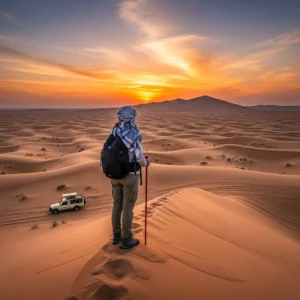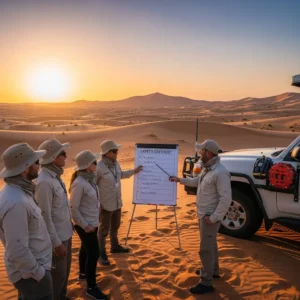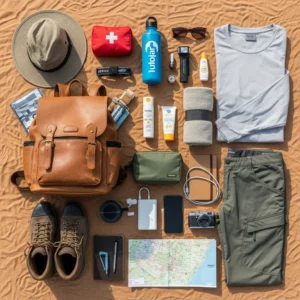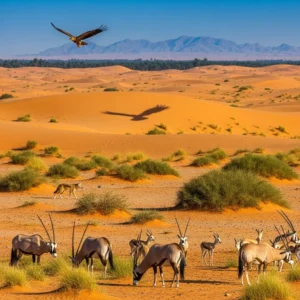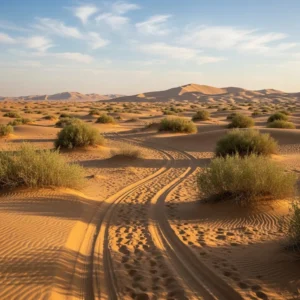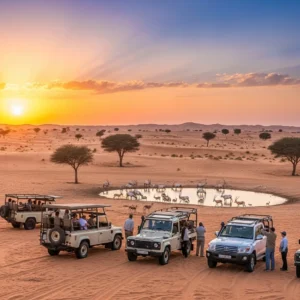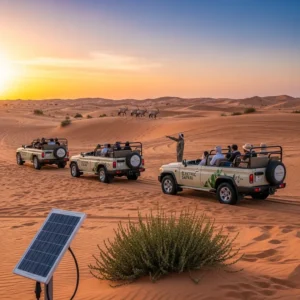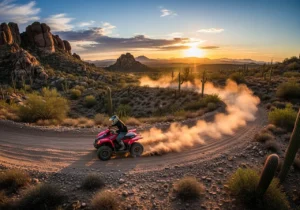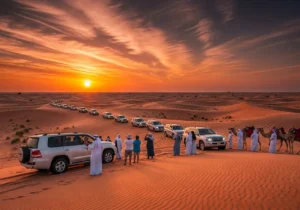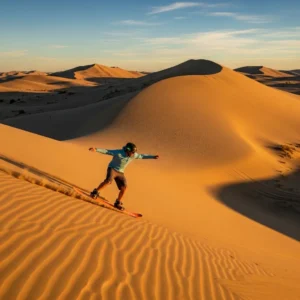Table of Contents
ToggleGreening the Golden Sands: 10 Powerful Ways to Enjoy an Eco-Friendly Desert Safari
The Arabian desert is a place of breathtaking beauty and profound tranquility. Its vast, rolling dunes and unique, resilient wildlife create a magical landscape that captivates millions of visitors each year. However, this ecosystem is as fragile as it is beautiful. As tourism grows, so does our collective responsibility to protect it. This is where the concept of an eco-friendly desert safari comes in.
An eco-friendly desert safari is not about sacrificing fun or adventure. Instead, it’s about enhancing the experience by making conscious choices that respect and preserve the natural environment and local culture. It’s a journey that leaves a positive impact, ensuring that the magic of the desert can be enjoyed by generations to come.
This approach to desert exploration offers a more authentic and enriching adventure. It connects you more deeply with the landscape, its creatures, and its history. By choosing to travel responsibly, you become a guardian of the dunes, an active participant in conservation, and a supporter of sustainable practices.
Making your desert safari sustainable is easier than you think. It begins with awareness and a few deliberate choices. Let’s explore ten powerful ways you can transform your desert adventure into a truly eco-friendly desert safari. Many operators, such as https://royaldesertadventures.ae/, are increasingly offering options that align with these principles.
Why an Eco-Friendly Desert Safari Matters
Before diving into the “how,” it’s crucial to understand the “why.” The desert ecosystem is a delicate web of life. The sandy terrain, which seems robust, is easily scarred. Plants like the Ghaf tree have deep roots that stabilize the dunes and provide shelter for wildlife, but they are vulnerable to damage.
Mass tourism, if not managed properly, can lead to significant environmental degradation. Issues like soil compaction from off-track vehicles, litter that harms wildlife, and disruption of animal habitats are serious threats. An eco-friendly desert safari directly addresses these challenges by promoting practices that minimize our footprint and maximize our positive contribution.
10 Powerful Ways to Make Your Desert Safari Eco-Friendly
Embracing a sustainable approach can make your trip more meaningful. Here are ten actionable steps to guide you.
1. Choose a Tour Operator with a Strong Conservation Ethic
This is the single most important step you can take. A truly eco-friendly desert safari operator is one that builds its entire business model around sustainability. Look for companies that are transparent about their conservation policies. Check their websites for a dedicated “sustainability” or “environment” page.
Seek out operators who are official partners of the Dubai Desert Conservation Reserve (DDCR). These companies adhere to the strict environmental regulations of the reserve. They will have highly trained conservation guides, not just drivers. Reading reviews on platforms like https://hafiztourism.com/ can also provide insight into a company’s practices.
2. Respect the Wildlife: Observe from a Distance
One of the greatest joys of a desert safari is spotting native wildlife, such as the Arabian Oryx or the sand gazelle. The golden rule of an eco-friendly desert safari is to observe these creatures from a respectful distance. Never ask your driver to get closer for a better photo.
Feeding wild animals is incredibly harmful. It disrupts their natural foraging behaviors, can make them ill, and causes them to lose their natural fear of humans and vehicles, which can be dangerous for them. A true wildlife experience is about seeing animals in their natural, undisturbed state.
3. Stay on Designated Tracks
The thrill of “dune bashing” is a popular part of many safaris, but there’s a right way and a wrong way to do it. An eco-friendly desert safari practices responsible “dune driving.” This means using designated tracks and routes to minimize damage to the desert terrain.
Driving randomly across the desert compacts the sand, which prevents native grasses and shrubs from growing. This vegetation is a vital food source for wildlife and helps to prevent desertification. Sticking to the tracks protects this fragile life.
4. Eliminate Single-Use Plastics
Plastic waste is a global problem, and it looks particularly ugly in a pristine natural landscape. A key principle of an eco-friendly desert safari is to refuse single-use plastics. Start by bringing your own reusable water bottle.
When choosing an operator, ask about their waste policy. Do they use proper reusable plates, cutlery, and cups at their camps? Or do they rely on disposable plastic and styrofoam? A small choice like this makes a huge difference in the amount of waste left behind.
5. Leave No Trace: Pack It In, Pack It Out
This is the fundamental mantra of responsible tourism. It means that everything you bring into the desert, you must bring out with you. This includes everything from water bottles to snack wrappers.
Take it a step further. If you see a piece of litter left by someone less considerate, pick it up and dispose of it properly back in the city. In the arid desert environment, a simple plastic bottle can persist for hundreds of years, posing a threat to wildlife and spoiling the natural beauty.
6. Support Local Culture and Bedouin Heritage
Sustainability isn’t just about the environment; it’s also about people. An eco-friendly desert safari should also be socially responsible. Choose tours that celebrate and support authentic local culture, not just a superficial version of it.
This means booking with companies that employ local guides who can share genuine knowledge about their heritage. It involves visiting camps that serve authentic Emirati food and showcase traditional arts and crafts. This ensures that your tourism dollars are supporting the local community.
7. Dress Appropriately and Responsibly
Your choice of clothing can also have an environmental impact. Opt for clothes made from natural, breathable fabrics. More importantly, avoid wearing clothing with glitter, sequins, or other decorative elements that can easily detach and become micro-litter in the sand. These tiny particles are impossible to clean up and can be ingested by wildlife.
8. Opt for Human-Powered Activities
While motorized sports are a big draw, an eco-friendly desert safari often emphasizes activities with a lower carbon footprint. These experiences can also offer a much deeper and more peaceful connection with the desert.
Consider a tour that includes a guided nature walk with a conservation expert. Opt for a longer, more leisurely camel trek instead of a brief photo-op. Choose an experience that focuses on stargazing, teaching you about the constellations used by Bedouin travelers for centuries. You can explore various activity options on sites like https://dubaidesertsafarie.com/.
9. Educate Yourself About the Desert Ecosystem
A truly responsible traveler is an informed one. Take the time to learn about the desert you are visiting. An eco-friendly desert safari should be an educational experience.
Engage your guide in conversation. Ask questions about the Ghaf tree, the different types of dunes, and the adaptations of the animals that live there. The more you understand the ecosystem, the more you will appreciate its fragility and the importance of protecting it. This knowledge is something you will carry with you long after the trip is over.
10. Spread the Word and Provide Constructive Feedback
After your trip, share your positive experience. When you write a review, specifically mention the operator’s sustainable practices. This not only rewards the responsible company but also informs other travelers and encourages them to make similar choices.
If you see practices that could be improved, provide that feedback constructively and privately to the tour operator. Your perspective as a guest is valuable and can help them become even better stewards of the environment.
The Dubai Desert Conservation Reserve (DDCR): A Gold Standard
When discussing an eco-friendly desert safari, it’s impossible not to highlight the Dubai Desert Conservation Reserve (DDCR). This is a massive, protected area of land dedicated to preserving the desert’s natural heritage.
The DDCR was established for the specific purpose of protecting the biodiversity of the Arabian desert. Access to the reserve is strictly limited to a handful of approved tour operators who must follow stringent conservation-focused guidelines. These operators pay a portion of their fees directly back into the conservation efforts of the reserve.
Choosing a safari that operates within the DDCR is one of the surest ways to ensure your experience is sustainable. These tours are designed around conservation, with activities like nature drives to see reintroduced species like the Arabian Oryx. The guides are not just drivers; they are trained conservationists who provide incredible educational value.
Standard Safari vs. Eco-Friendly Desert Safari: A Comparison
The differences in approach and impact become clear when you compare a standard tour with a truly eco-friendly one.
| Feature | Standard Safari | Eco-Friendly Desert Safari |
| Primary Goal | High-energy entertainment | Conservation and education |
| Driving Style | Aggressive, often off-track | Regulated, on designated tracks |
| Wildlife | Seen as a quick photo-op | Observed respectfully from a distance |
| Waste Mgmt. | High use of disposable plastics | Emphasis on reusables, zero-waste goal |
| Cultural Focus | Often superficial shows | Authentic heritage and local guides |
| Pace | Rushed and crowded | Leisurely, intimate, and peaceful |
A standard safari might offer a thrilling ride, but an eco-friendly desert safari offers a connection. It provides the peace of mind that comes from knowing your adventure is contributing to the preservation of the very beauty you came to witness.
Conclusion: A More Meaningful Adventure
The golden dunes of the Arabian desert are a natural treasure. As visitors, we have a choice: to be passive consumers of the landscape or to be active partners in its preservation.
Choosing an eco-friendly desert safari is a commitment to a better way of traveling. It’s a decision that enriches your own experience while leaving a positive legacy. By following these ten principles—from selecting a conservation-focused operator like those found at https://royaldesertadventures.ae/ to simply carrying a reusable water bottle—you can make a powerful and positive impact.
Your journey into the desert can be more than just a memory; it can be a statement of your values as a thoughtful and responsible global citizen.
Frequently Asked Questions (FAQs)
1. Are all standard desert safaris bad for the environment?
Not necessarily, but they often lack the primary focus on conservation that defines an eco-friendly desert safari. Standard safaris are built around entertainment and volume, which can lead to practices that are detrimental over time, such as higher waste production from disposables and less stringent driving protocols. The key difference is the operator’s core philosophy—is it conservation-first or entertainment-first?
2. What is the Dubai Desert Conservation Reserve (DDCR) and why is it important?
The DDCR is a legally protected nature reserve and the first of its kind in the UAE. It makes up a significant portion of the emirate of Dubai and is dedicated to safeguarding the natural desert habitat and its biodiversity. It’s incredibly important because it provides a safe haven for native species, including the successfully reintroduced Arabian Oryx, and serves as a living laboratory for conservation science. Safaris inside the DDCR operate under strict rules, making them a gold standard for eco-tourism.
3. How can I really tell if a tour operator is genuinely eco-friendly?
Look for tangible evidence beyond marketing buzzwords. Check if they are an official partner of the DDCR. Look for a detailed sustainability policy on their website. Do they mention their waste reduction strategies, their use of conservation-trained guides, or their support for local communities? Genuine eco-operators are proud of their efforts and are transparent about them. Vague claims like “we love the desert” are not enough.
4. Does an eco-friendly desert safari still include fun activities like dune bashing?
Yes, many do, but it’s conducted responsibly. The term is often shifted to “dune driving.” The activity takes place on designated, pre-established tracks to prevent damage to virgin desert areas. The thrill and excitement are still there, but it is controlled and managed to ensure minimal environmental impact. An eco-friendly desert safari balances adventure with responsibility.
5. What happens to the waste generated at the desert camps?
This is a critical differentiator. In a standard camp, large amounts of waste, much of it plastic, are collected and sent to a landfill. A truly eco-friendly desert safari camp is designed to minimize waste from the start. They use reusable crockery, cutlery, and linens. They avoid single-serving packets for condiments. Food waste is often composted. What little waste is generated is carefully sorted for recycling and removed from the desert completely.
6. Are the camels used for rides treated ethically?
This is a vital part of social and ethical sustainability. A responsible operator will ensure their camels are healthy, well-fed, hydrated, and not overworked. The animals should have shaded resting areas. Observe their condition: they should look healthy and not show signs of distress. Ethical operators view their camels as valuable partners and treat them with care and respect.
7. Will an eco-friendly safari be boring compared to a regular one?
Not at all. In fact, most people find it more engaging and enriching. While it may have less of a high-energy party atmosphere, it replaces that with deeper, more memorable experiences. The thrill of spotting a rare Oryx, the peace of a silent sunrise, the taste of authentic food, and the knowledge gained from an expert guide are far from boring. It’s a different kind of excitement—one that is more profound and lasting.
8. What is a “conservation guide” and how are they different from a regular driver?
A regular driver is trained to navigate the dunes and entertain guests. A conservation guide has all those skills, plus extensive training in the local ecology, biology, history, and culture. They can identify animal tracks, explain the medicinal uses of desert plants, share stories about Bedouin traditions, and answer in-depth questions about the conservation efforts you are supporting. They transform the trip from a simple ride into a rich educational journey.
9. Why is avoiding single-use plastic so important in the desert?
The desert’s arid environment lacks the moisture and microorganisms needed for plastic to biodegrade. A plastic bottle can remain intact for over 400 years. During that time, it can break down into smaller microplastics that contaminate the soil and can be ingested by wildlife, causing injury or death. Furthermore, plastic litter is a visual blight on a pristine natural landscape.
10. Does an eco-friendly safari cost more than a standard one?
Sometimes, yes, but the value is significantly higher. Operating sustainably has costs: paying for highly trained guides, adhering to strict reserve regulations, investing in reusable materials, and contributing a portion of fees to conservation. You are not just paying for a tour; you are investing in the preservation of the desert. The more intimate group sizes also contribute to a premium, higher-quality experience.
11. What is the Ghaf tree and why is it important to protect?
The Ghaf is the national tree of the UAE and is a keystone species in the desert ecosystem. It is incredibly drought-resistant, with roots that can go down 30 meters to find water. Its leaves and pods provide food for various animals, and its branches offer crucial shade and shelter. It also stabilizes the soil. Protecting Ghaf trees from damage by vehicles is a key priority of any eco-friendly desert safari.
12. Can I bring my own snacks and drinks?
While most tours provide everything you need, if you do bring your own snacks, ensure you follow the “pack it in, pack it out” rule. Choose items with minimal packaging. For example, bring a piece of fruit instead of a bag of chips. And absolutely make sure your reusable water bottle is the only beverage container you bring.
13. How does light and noise pollution affect the desert?
The desert is a naturally dark and quiet environment, and its wildlife is adapted to this. The bright lights and loud music common at many standard safari camps can be highly disruptive. It can disorient nocturnal animals, affect their hunting and mating patterns, and spoil the natural ambiance. An eco-friendly desert safari camp uses minimal, low-impact lighting (like lanterns) and forgoes loud music in favor of the natural sounds of the desert or soft, traditional music.
14. What is “social sustainability” in the context of a desert safari?
Social sustainability focuses on the well-being of the local community. It means your tour contributes positively to the people whose culture it represents. This includes hiring local Emiratis as guides, paying fair wages, supporting local artisans by selling their crafts ethically, and presenting the Bedouin culture in an authentic and respectful manner, rather than as a caricature for entertainment.
15. Are there any certifications I can look for to verify an operator’s claims?
While a global, standardized “eco-safari” certification is not universally applied in Dubai, the most important credential is being an approved operator for the Dubai Desert Conservation Reserve (DDCR). This is a formal vetting process that guarantees the operator meets a high standard of environmental practice. Look for the official DDCR logo on their website and marketing materials.
16. What kind of food is served on an eco-friendly safari?
The focus is typically on authenticity and sustainability. This often means a menu of traditional Emirati dishes made with locally sourced ingredients where possible. This reduces the carbon footprint associated with transporting food over long distances and supports local farmers. The dining experience is part of the cultural immersion.
17. Can I volunteer for any conservation efforts during my trip?
While direct volunteering is not typically part of a one-day safari, your participation in a tour within a reserve like the DDCR is a form of contribution. The fees you pay directly fund the reserve’s conservation work, including wildlife monitoring, habitat restoration, and research. You are actively funding conservation simply by choosing the right tour.
18. What is the best way to photograph wildlife without disturbing it?
The key is to use a camera with a good zoom lens. This allows you to get a clear, close-up shot from a respectful distance without needing to approach the animal. Turn off your camera’s flash, as it can startle the animals. Be patient and quiet. The goal of an eco-friendly desert safari is to be a silent observer, capturing moments without altering them.
19. Does “Leave No Trace” apply to organic waste like an apple core?
Yes, it does. While an apple core is biodegradable, it is not native to the desert ecosystem. Decomposing foreign food can attract animals and alter their natural diet. It can also take a surprisingly long time to break down in the arid environment. The principle of Leave No Trace means leaving the environment exactly as you found it, so even organic waste should be packed out.
20. How can my single trip really make a difference?
It makes a huge difference. The tourism industry is driven by consumer demand. When you actively choose and pay for an eco-friendly desert safari, you are sending a powerful economic message. You are supporting the companies that do things right and creating a financial incentive for other companies to improve their practices. Your single choice, multiplied by thousands of other conscious travelers, is what drives positive change in the industry.

